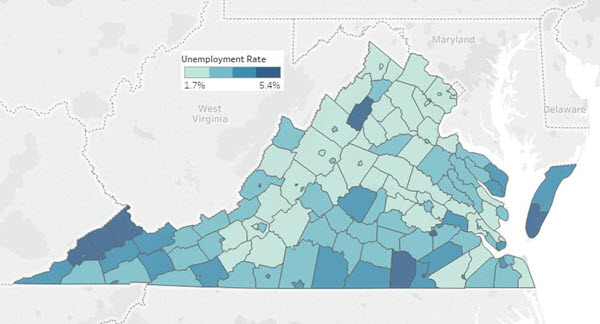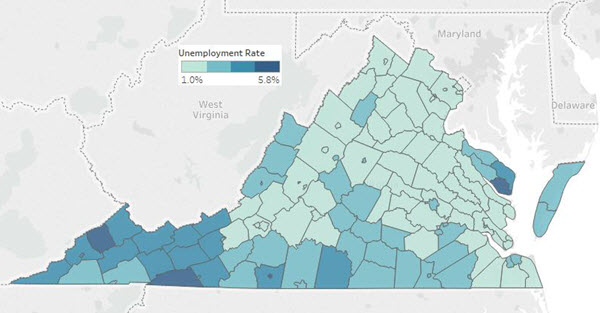Local Unemployment Rates in Virginia: How Low Can They Go?
As of December 2018, Virginia's unemployment rate was 2.8 percent, which was one of the lowest rates in the nation, and was down from 3.6 percent in December of the previous year. Moreover, unemployment rates declined in every county and independent city in the Commonwealth from December 2017. But how do the most recent rates compare with previous lows?
The most recent figures from the Bureau of Labor Statistics showed unemployment rates in Virginia's counties ranging from 1.7 percent in Arlington County to 5.4 percent in the city of Petersburg in December 2018. (In Virginia, independent cities are considered "county equivalents.") Additionally, more than 80 percent of the state’s 133 counties had an unemployment rate below the December national rate of 3.9 percent.
The map below shows that the lowest jobless rates tended to occur in the northern, central, and Shenandoah Valley regions. Meanwhile, some of the highest unemployment rates in Virginia occurred on its eastern peninsula, along the state's southern border, and in the far southwest counties near the Appalachian Mountains.
Compared to December of the previous year, the majority of counties in Virginia saw unemployment rates decline by somewhere between half a percentage point and one and half percentage points. Interestingly, some of the smallest and largest declines occurred in areas that had the highest unemployment rates. For example, the city of Emporia had the second highest jobless rate in December 2018 at 5.3 percent but only saw a decline of 0.2 percentage point over the year. Meanwhile, one of the largest declines of 2.0 percentage points occurred in the city of Petersburg, the place with the highest unemployment rate in the state.
For perspective, we can compare current unemployment rates to those just prior to the Great Recession and prior to the 2001 recession, when the nation, Virginia as a whole, and most parts of the state experienced some of their lowest unemployment on record. First, unemployment rates are currently lower in 83 of the Commonwealth's 133 counties compared to where they were just prior to the Great Recession. However, only 17 counties currently have unemployment rates lower than they did in December 2000. At that time, 42 counties had rates that were below the lowest current rate of 1.7 percent and the lowest rate was 1.0 percent in the city of Fairfax. (See map below.)
Comparing the two maps above shows a larger number of counties with low unemployment rates in 2000 than in the most recent period. It also shows that higher unemployment rates were slightly more clustered around southwest Virginia in 2000, whereas on the eastern peninsula, for example, the rates were more in line with other parts of the state.
Of course, unemployment rates can decline due to people exiting the labor force as they move out of an area or if they just stop looking for work. In a majority of counties in Virginia, the most recent unemployment rate decline (from December 2017 to December 2018) corresponded with an increase in the labor force. However, 17 counties in the state simultaneously experienced a decline in the number of people unemployed and the labor force. In fact, those same places also saw a decline in the number of people employed, even as the unemployment rate declined. Interestingly, the common factor among those places is that they are either rural counties or small cities, like Danville or Lexington.
In sum, unemployment rates have declined across every county and independent city in Virginia in the last year, but many places have yet to reach the previous lows reported prior to the Great Recession and the vast majority of counties are still above the historical lows set in late 2000. Additionally, in some counties, particularly those in more rural areas, part of the reason for the decline is that people have left the labor force.
Have a question or comment about this article? We'd love to hear from you!
Views expressed are those of the authors and do not necessarily reflect those of the Federal Reserve Bank of Richmond or the Federal Reserve System.



